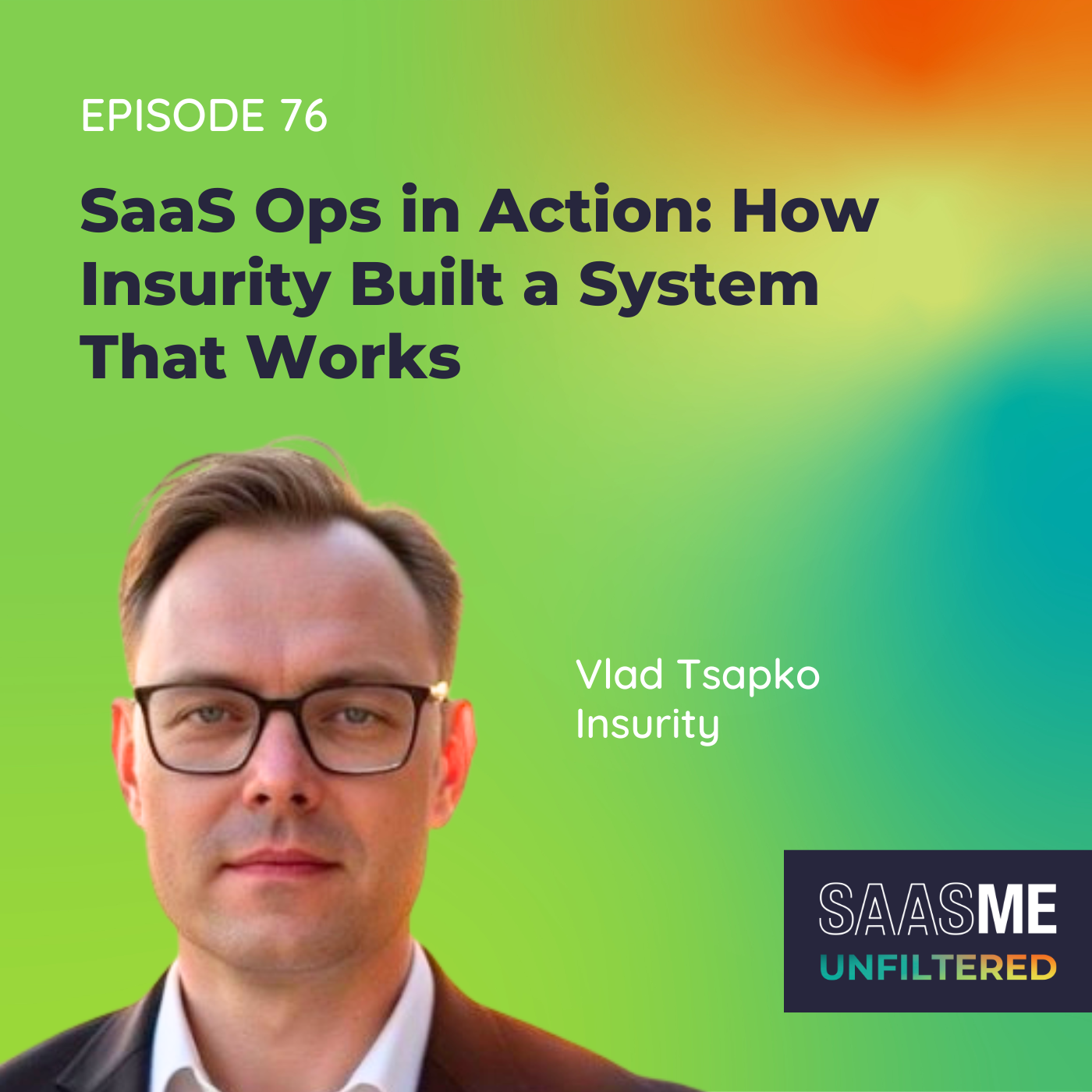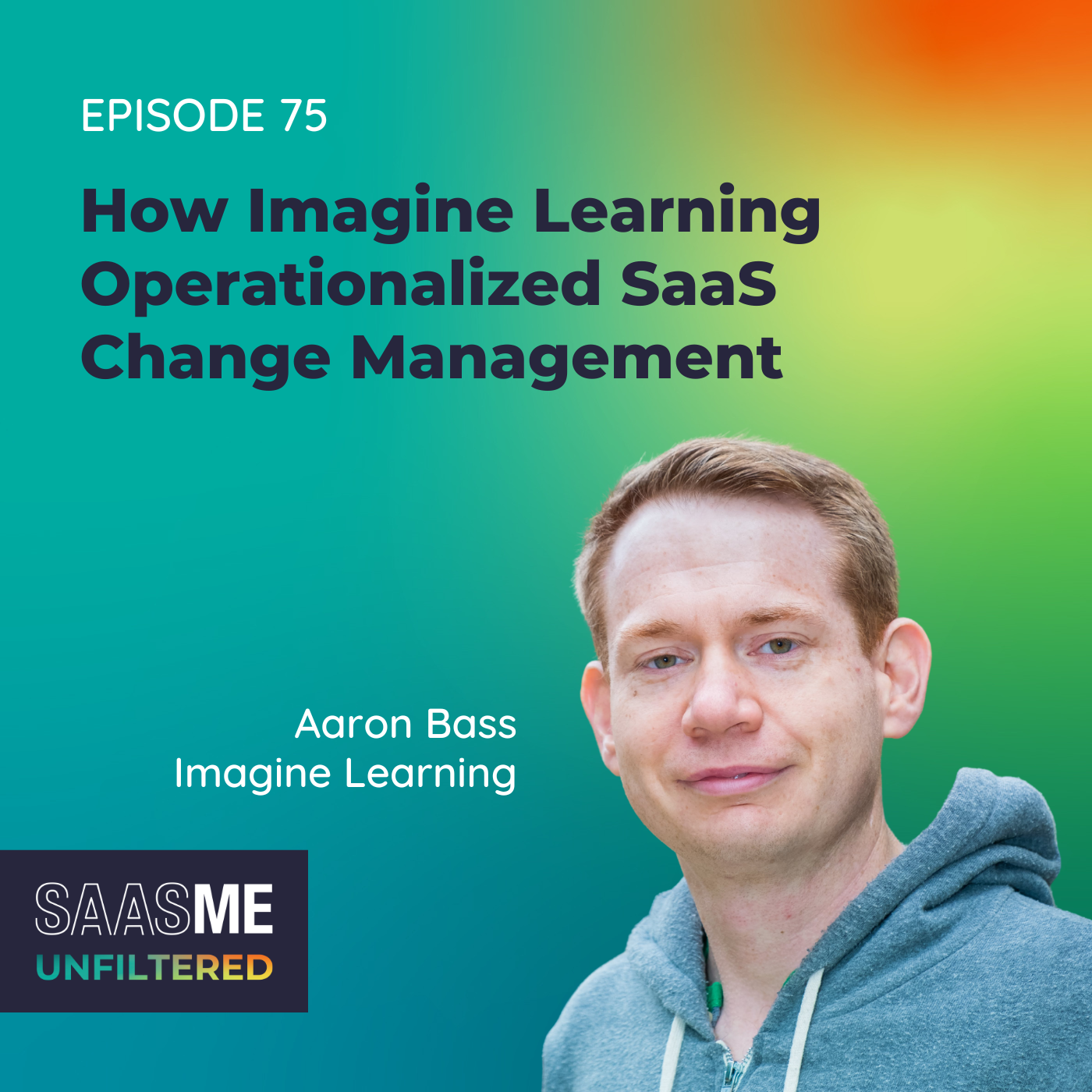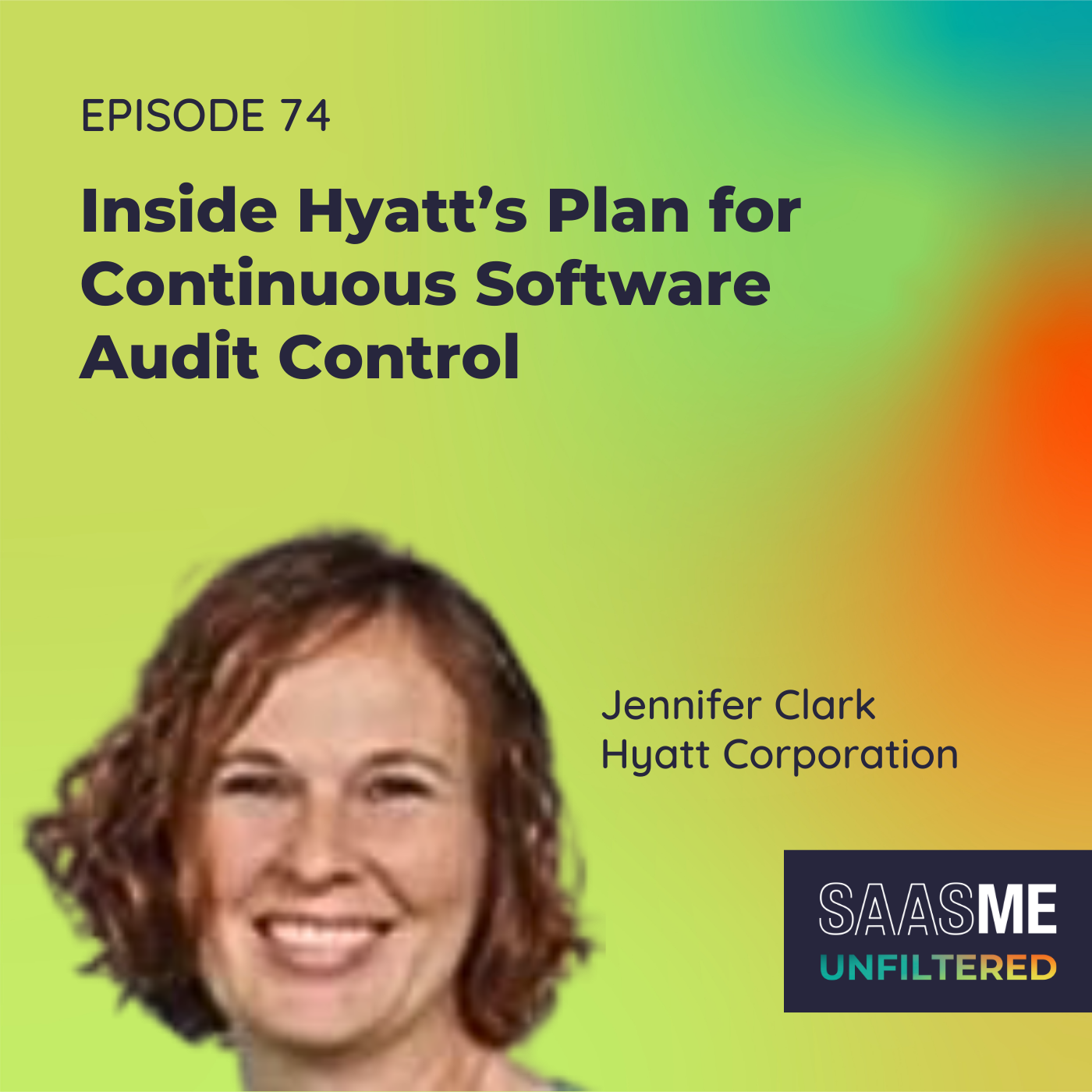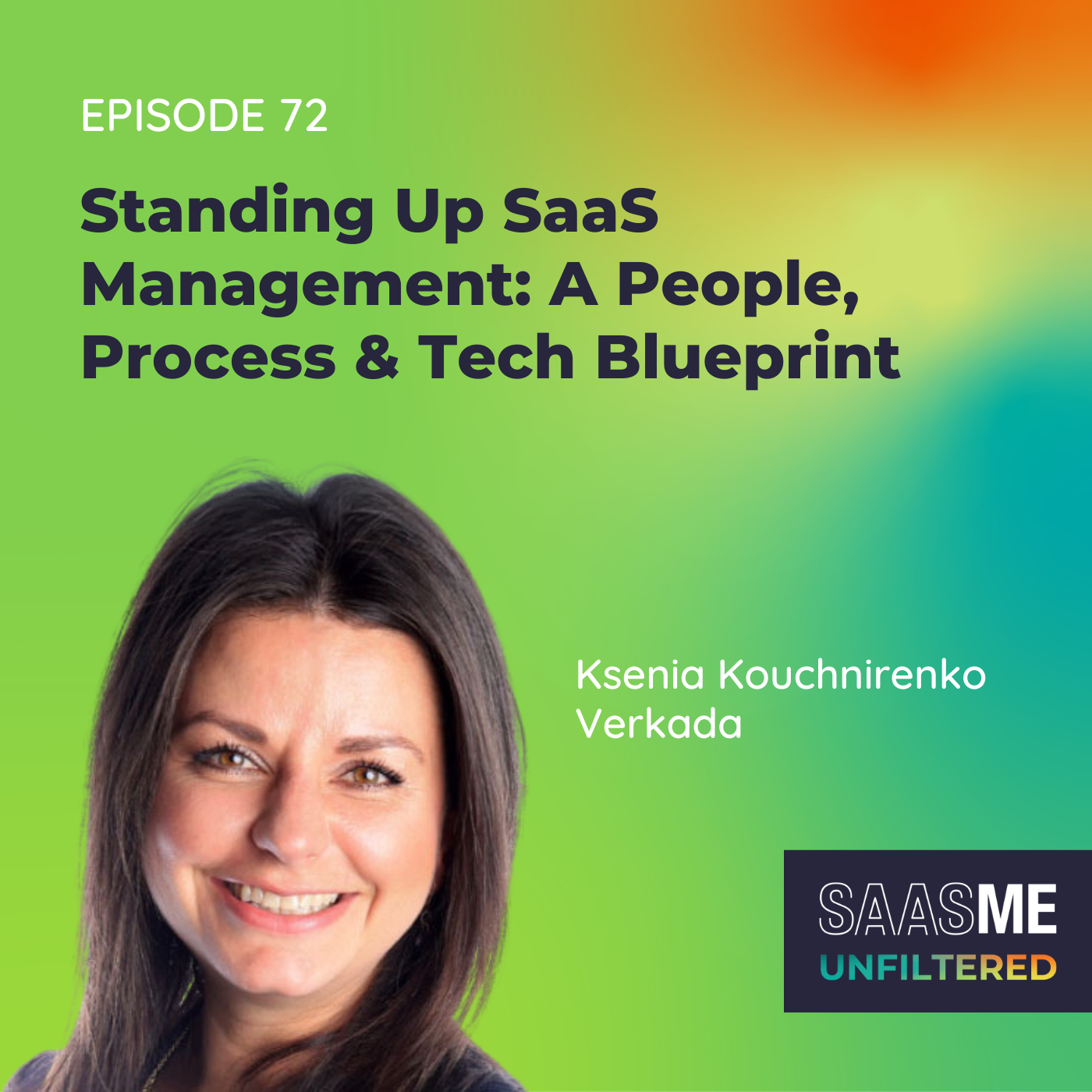Gibson Schnurr: How to Start a SaaS Management Program as a Small But Mighty IT Team
- 0.5
- 1
- 1.25
- 1.5
- 1.75
- 2
Gibson Schnurr: The biggest thing is, before, I worked in managing those tools in terms of determining what those tools are, who's using them, how much they cost and what they're used for. And then very little time in taking strategic decisions on how we should act on those tools, in the scope of the entire organization, which I think is what my role is more hired for in both cases. It's more about acting on the data, acting on the problems, the gaps, the pain points instead of finding them.
Cory Wheeler: Hello, hello and welcome to SaaSMe Unfiltered: The SaaS Management Podcast, the show with give it to you straight, real life advice from pros knee- deep in SaaS every single day, SaaS management superheroes just like you. Welcome back to another episode of SaaSMe Unfiltered. Very excited to have everyone joining us today. I'm Cory Wheeler, Co- Founder and Chief Customer Officer at Zylo.
Meredith Albertson: And I'm Meredith Albertson, the Chief Marketing Officer at Zylo.
Cory Wheeler: Well, we are very excited to have today's guest joining us on the podcast. This is an accomplished and stakeholder- focused application manager. He's got seven years of experience and that experience spans fintech startups and tech giants. So he's previously held roles at Zettle and Epic, and is currently the IT product application systems manager at Juni. He takes an employee- centric approach to application management to enable organizations to mean agility and flexibility while mitigating risk and costs. Personally, he loves to grill. He's an Iowa State University grad and now he lives in the woods in Sweden. He is also a 2023 Zylo SaaSMe award winner. So please welcome to the podcast Gibson Schnurr. Gibson, thanks so much for joining us today.
Gibson Schnurr: Yeah, thanks for having me. I'm really excited to dig into some of the minutia here within SaaS management.
Cory Wheeler: Well, let's get into it. You are somewhat early in your journey around SaaS management at Juni. It's been really fun to see you jump in and hit the ground running with your program. So today we're going to get an inside look at that story, what that path was that led you to SaaS management, and then take a step back and get a look at a day in the life, what that typical day in the life looks like for an IT program, project manager, wrangling applications throughout your business. So we're going to start on that road to SaaS management. So, you're one of two folks on your team, setting the stage here a little bit, one of two folks on your team growing that team. So this is really a fresh perspective on SaasMe Unfiltered, so I'm super excited to get your takes around that as you're building the organization from the ground up. So if you could, Gibson, give us the 30,000- foot view about Juni, tell us about your role within the business and what that construct of the team, your team, looks like and what you're responsible for internally at Juni.
Gibson Schnurr: Yeah, definitely. So to start, to give a shout- out to Juni, Juni is a financial platform for digital commerce. Juni gives businesses the complete visibility and control over their cashflow with a unified view of multicurrency, business accounts, corporate virtual cards, and flexible credit. And we are adding a lot in terms of all- in- one insights and analytics. So, I started here after leaving PayPal in Sweden, after the acquisition by PayPal, by Zettle, where was my, I would say my first official position within this IT sphere of SaaS management. And there I learned a ton from the people I worked with and a ton about the industry, about SaaS and how it impacts the organization. And when I started at Juni, I applied a lot of those lessons. The biggest one being is you spend so much time just trying to find out what you should be managing, what exists, what impact that has on the organization. I think a lot of organizations, especially over the last year and a half, are focused on cost reduction and I think that's definitely a big part of it and that was a big reason why we started moving into a more automated SaaS management flow, especially through our financials, one of the huge advantages Zylo provides. And it's been a crazy ride from there. I would say knocking down our total SaaS application sprawl from 500 to about 140 now in about a little under a year is pretty crazy.
Cory Wheeler: That's impressive.
Gibson Schnurr: Yeah, I think we got most of them out in the first six months. I would say one of the hardest things about this was making sure that we presented the value correctly to the organization. I know right now, currently, our Zylo user base is quite limited to my team and then some of the leadership within our organization. And with that small visibility, it makes it a little bit difficult at our organization to make sure that we show the value. But then when you take into account the amount of FTEs saved by not having to reach out to random people like, " Hey, I see this Slack message that you bought this tool. Why? How are you spending it?" I can just see who spent it on what credit card, accounts payable, easily decide how to take action on it from there. So, from a 30, 000- foot view, it all comes down to easing the load on us to make actual decisions about the tech stack and not determining what that tech stack is.
Cory Wheeler: That's really impressive. I want to double click on how you were able to drive such big outcomes early on in your SaaS management journey. You went from 500 to 100 and some odd applications. Typically, for folks that are looking at SaaS management, they begin with seeing insights around all of their applications and seeing the low hanging fruit that they're cleaning up. And that last step becomes an application rationalization strategy, which is much more difficult to get buy- in through the organization, to make sure that executives are aligned around a strategy and those are one- off conversations that for some large organizations take quarters or years to have before they're able to transition and bring those applications into larger, shared apps across the organization. So, maybe double click into that process a little bit. You saw that you had 500 applications. How were you able to drive such rationalization strategies that quickly, as soon as you went live with Visibility and Zylo?
Gibson Schnurr: Yeah, I would say there's a couple big factors. I don't want to limit it to a specific number, but a big one is that it was quite early in the company's journey, a couple years in. We had just started your traditional IT, I would say, team within the organization. So it was a new thing for the organization to have somebody directly managing this outside of the engineering department. And then another is I don't believe I've had such top- down buy- in within a team like this before. We presented a very large decision to the founders about a direction we wanted to make that would have quite a substantial monetary impact and in the short term maybe would cost us more. And in the end, our CEO just said, " You guys are the experts. We'll trust you." I think that's been what's so easy. And then we are not also just saying, like; " Here, use this tool." I think the philosophy that we are explaining as we're switching the tooling is quite important as well. It gives a lot of context to the end users. So yeah, I would say it's mostly the buy- in and then just being able to take the time with the end users and explain why we're rationalizing, even if they're not always happy about it.
Cory Wheeler: That's it. Executive buy- in around any sort of governance decision like that, that's what greases the skids, we like to say, to be able to drive progress there. Yeah.
Gibson Schnurr: Yeah, absolutely.
Cory Wheeler: In a young team then you're doing everything. So you're managing technology, procurement, risk management, compliance. I think the first step was getting to a reasonable number of applications that you could standardize throughout the organization, but maybe explain a little bit how much you're covering off on in the application lifecycle for your products internally at Juni.
Gibson Schnurr: Yeah, so for the internal SaaS that we're using and even quite a bit of the third party technology we're buying to go into our product, we cover everything you can think of from beginning to end. So, in helping the end users identify the right tooling, negotiating with those vendors. We don't really really have a request for a proposal process, we just find the top couple that we like, compare some price and compare some capabilities. And then from there it's implementation. Depending on the capability of the team we're working with and their bandwidth, maybe they would have somebody run the project with us as a consulting partner in helping them or we would run the project, helping them build it from the ground up. We're always involved in determining this RASCI model of roles within how the ownership is, who should be doing what and when, as the lifecycle goes. Like; what is admin versus what is self- service for that tool? And then from there, whatever support we can have, which includes an identity and access management during the implementation process, but making sure we have the right automated flows to ease up the workload on us. So, we're not really involved so much in the granting of access anymore. We have it assigned to the specific groups that own those tools and it just comes right to their Slack, which is fantastic. And I would say from there, if their need is a little bit of development, we handle it. If it needs to be sunset or canceled, we handle it, thanks to Tory from Zylo as well though. She's a really big help in making sure that we get a good price and then if we need to cancel it, make sure we cancel it in the appropriate way according to the terms.
Cory Wheeler: Everything, everything.
Gibson Schnurr: So everything, it seems like everything. I'm sure there's things I'm missing, that's not everything, but then there's also documenting risks in terms of what can and can't be acceptable. If they don't have a SOC 2 report, we ask them to fill out a CIAQ Lite and that's reviewed by our InfoSec team and document those risks in a centralized location as well. So it's a pretty broad scope.
Meredith Albertson: Well, Gibson on a smaller team, you have to wear a lot of hats. And historically I can imagine that that has made it tough to manage all the things you mentioned, manage that across all of your applications, especially without a platform. Now, that is a common sentiment that we hear from customers, that their life before using a SaaS management tool is vastly different than after. But there are a lot of companies that are out there, a lot of our listeners today, that are still trying to figure this out and I'd love to talk a little bit more about your experience. What was your day- to- day like before using a SaaS management platform? What were your biggest headaches? And I'm sure some of our listeners are going to be like, " Aha, I'm feeling that too."
Gibson Schnurr: Absolutely. And I think when I started at Juni, I came with this idea that we needed some form of solution. I wasn't very aware of the solution industry around this problem. So I came in with the idea that I needed to develop something to handle and automate this for us. And as I started to take on that beast, I was like, " All right, this isn't necessarily my competency. It's not a great use of my time." So I went into the marketplace and found products beyond any capabilities that I thought that there was. And especially with Zylo, I think a big advantage is the agentless approach. We can get into that at a different time. That's a bit of a digression. But before that, it was all manual. So we were using products akin to Excel spreadsheets to manage. Relational databases, that's completely manually updated and I think it takes a substantial amount of manpower, not only to first aggregate that list, but then by the time that that list is aggregated, it's already out of date and it can be out of date in terms of not only the tools that you're using, but let's say the data classification within those tools, making sure that the scope of that data that should be contained there doesn't creep. Because that is a big thing. If somebody buys a tool for public data and now we're using it for personal or confidential data, that needs to be documented, and then we need to have the appropriate security compliance and risk controls in place for that tool, which might not be the same during the procurement process. So yeah, I would say it's just the biggest thing is before, I worked in managing those tools in terms of determining what those tools are, who's using them, how much they cost and what they're used for, and then very little time in taking strategic decisions on how we should act on those tools in the scope of the entire organization, which I think is what my role is more hired for in both cases. It's more about acting on the data, acting on the problems, the gaps, the pain points instead of finding them. And I think Zylo takes a really large chunk out of that, or a SaaS management tool. Obviously we chose Zylo for a reason. I think they are a industry leader. I think you guys are. It's interesting, sometimes you measure the value of tools by how often and how long you're interacting in those tools. And I think a beauty of Zylo is on a Monday morning, open it up and I can see new spend right away. I can see what's our trend for this year in terms of budget and allocate that to a different tool request that we're getting, within 10 to 15 minutes. And these are things that we would spend months aggregating, going through different spreadsheets, seeing, " Okay, how's this?". And then reaching out to finance to go into the ERP, " How much have we actually spent of this budget." And then them getting back to me a couple days later. So information that was typically disparate, hard to aggregate and view is now in one place and I can action on it then. And it doesn't take out some of the game of telephone of like, " Okay, we didn't spend this money on this tool." Then you got to ask finance, " Do we want to take that as we've done really good or can I use it for something else?" But that's standard process in every organization, so it really takes a lot of the hurdles out of the way.
Meredith Albertson: Absolutely. You mentioned something just a couple minutes ago about the manual work and now being able to do more strategic work. What is that? What's some of this exciting, more strategic work that you feel like you've been able to have more bandwidth and brain space for?
Gibson Schnurr: I think the biggest one, and we've talked about it, is approaching rationalization in a better way. Because before it's like, " Okay, we have cost these two tools." We've got, let's say, Trello, JIRA. " I've got these two tools, we have to choose one." And you're already thinking about the other tools that you might need to rationalize, " Oh, you need to spend more time finding other cost saving opportunities", because that is very time- consuming. So now we can really dive down into the merits of both quicker and we can find; maybe we don't need either of these and we need to buy something else, because we actually are focused on this special set of capabilities in this realm. And I think that's a really direct impact. Another is pursuing things you're more interested in, like let's say tools that have a bit more developmental need and being able to help create a back office within your organization that's automatic. So I think it also increases, at least in my case, some more enjoyment instead of just messaging people all over the organization, " How are you using things? Why are we spending this money?" You get out of the what makes people mad into more into what makes people glad, I would say.
Cory Wheeler: I like that. It's a good way to look at it, and I like the approach of looking at the different sets of solutions, getting that visibility and then starting to dig into them. On top of that, did you have a specific scenario, or as we like to refer to it an oh shit moment, that drove the business to prioritize getting in a SaaS management tool for this visibility? What was the large driver and anything that snuck up and was urgent beyond any other need that you had?
Gibson Schnurr: Yeah, I think there's a couple things here. One, my own experience in knowing that I didn't want to work in this way of, " Oh, we'll become strategic, we'll become strategic, we'll become strategic", when the discovery work was done, which products like this exists, because the discovery work's never done. There's always new spend. No matter how many controls you put in place, somebody's going to go out and buy a productivity tool, which is a small drop in the bucket, but when everybody can do it, that bucket fills up real quick. But in terms of Juni specifically, just looking at what have we authenticated with Google, seeing this massive list and how many times people have logged in and where, and then seeing the regulated environment that we were moving into and really seeing this as a non- starter, we can't have this type of data sprawl, uncontrolled data sprawl. So that was a bit of our oh shit moment. I think we were early enough and security and safety was so ingrained in the organization, there was nothing scary, but it's just like; let's just keep it safe that way.
Meredith Albertson: Yeah, absolutely. One of our past guests on the show said that it's never too early to start SaaS management, but this can be somewhat daunting, especially if you're on a leaner, smaller team. What's your advice to our listeners today that to make the case for this and ultimately get started?
Gibson Schnurr: Yeah, you can break it down in a couple ways. I think the easiest is everybody likes money. Follow the money. You save so much money in terms of having a tool like this, and I think we've talked about this before, but my philosophy here is it's very akin to other emerging roles within existing industries, such as supply chain management, which is what my degree is in. They typically just had somebody who didn't have a specific training in terms of process optimization, logistics, cost savings through materials, processes, et cetera. And as the studies have gone on and shown that if you really harness optimization and increases in performance in those areas, you can cut dollars from your spend to increase your profit instead of having to spend more dollars to increase your profit through revenue. And I think it's the same with SaaS management. The more ability that you have to optimize, make your solutions scalable, you're better to cut off some of your costs to increase your profit, and it's cheaper than increasing your profits through increasing your revenue. The cost for customer acquisition can be quite high versus the cost of optimizing your tech stack can be quite low, and I think that's where you can really impact your bottom line. So I think that's the easiest thing in terms if we just look at the money and then you can see that it's going to make your team make better, quicker decisions, which is going to increase that gap. It's all about using the buzzword data driven. This really takes that to now data, now driven, instead of data I collected over the months, some of it's stale and moving from there.
Meredith Albertson: If you're not unlocking the full value of your SaaS, what are you doing? There is no denying it, SaaS is mission- critical to your company's growth and success. And as the number two operating expense for most organizations, it's your biggest opportunity to save money and drive efficiency. The time is now to do something about it. Join me and your fellow IT, SAM, finance and procurement leaders at SaaSMe. SaaSMe is the industry's only dedicated SaaS management event where you can sharpen your skills, hear from your peers, and learn how to unlock value and responsible business growth through smarter SaaS management. Register today at SaaSMe. com. That's S- A-A- S- M- E. com.
Cory Wheeler: Yeah, partial data and the effort around continually updating that and making sure you've got a system of record is, in most scenarios, a losing proposition. As you take on more work, as there's less time to be able to focus on that initiative, you find that after a couple months you know that you've got an incomplete dataset and you're doing the best you can, but without automation to keep that running, you don't have centralized visibility, you don't have your arms around everything that's happening within the business.
Gibson Schnurr: Absolutely. One thing to expound on that is you typically see organizations trying to deal with this unruly thing to manage this unruly beast by buying a monolith, a product as a monolith, because it's all right there. You have your big dashboard for all these tools that sprawl multiple different areas, wherein some of those capabilities within that monolith application have now; they were best in class and maybe they still are in specific areas, but you've bought that tool that's not best in class. They do everything okay, a few things really well. Whereas you could spend less money, with effective insights to what you actually need and what you have, on buying a specialized tool following this microservice type methodology that are in products instead of the monolith. And I think organizations can move away from that crutch of like, " Oh, we sell all of this, so you only have to focus on this tool", to, " You can build your own tech stack, piece by piece." And I think that saves a lot of money as well as increases productivity, and you actually get the value propositions from those tools instead of buying one large value proposition where this crutch is included.
Meredith Albertson: That's really important. A lot of companies out there are trying to build a best of breed model for their business instead of just going in all on just a handful of tools. But, it sounds like you've got that strategy, you've got that visibility to be able to bring that to life at Juni.
Gibson Schnurr: Yeah, and that's definitely something, my wife might kill me, but my boss is my soulmate in this philosophy. We come in with the same mindset of really trying to give as much power as regulatory compliance and risk possible to the users, and that comes down to choosing specialized tools, choosing newer tools where the self- service mindset's more ingrained into them, into the product itself. It's really an interesting, I would say, it's not necessarily super new, but to really harness that as this philosophy behind how we're building things here and moving forward, it feels new to me at least.
Cory Wheeler: You've hit on a lot of strategic areas. You've hit on cost containment, driving better productivity, getting better value out of the applications you have internally, risk management. You've really hit on all of those large outcomes that you get from smarter management of your SaaS tooling inside your business. But as you've gone live, what do you consider as you take a step back, what's the biggest improvement or maybe one of the biggest insights that you got right after you went live with Zylo?
Gibson Schnurr: Yeah, I think it's hard, and this is where maybe the industry needs a next step, because some of this is fluffy, so it's hard to identify the perfect KPIs or cost equating dollars to this idea of productivity or this idea of acquiring more of the value proposition of a tool. And I think if we look at it from my personal view, I feel that we've done a really good job of increasing productivity, increasing cross- functional communication. We've done a good job of definitely increasing sustained security throughout the lifecycle of these tools, really taking a compliance first approach in terms of the tools that touch customer data. And I think that's very important. I think if we were to look at, I don't know, this thought of money where you could lose brand equity or you lose customer confidence, that area is probably the highest dollar amount, quote on quote. Whereas, then we've got real money we can actually show, based on Zylo reporting, based on other spreadsheet reporting of past data before we were with Zylo and before we were with our current ERP, where it was a bit more discombobulated that we've saved a lot of real money. And I think that's just always music to any leadership's ears, that; here is our team, our work, our tech stacks' ROI, and then you can bring up the fluffy stuff and say, " Well, if we had a data breach, we would've saved you this amount of money by this." Or; this third party, with the rise in frequency of supply chain attacks, knowing where your data is massive and saying, " We didn't go with that vendor, because we saw issues like this." Nobody's calculating that data. It's hard to prove, because it's a what if.
Cory Wheeler: Yeah. You're hitting on all of those different concepts. We talk about the value of strategically managing your SaaS estate, having that always on inventory, so you never are unsure of what's inside your four walls or what you're using in the cloud. You've got the ability then to understand all of your licensing in a centralized way. You're driving cost savings, as you mentioned, but then cost avoidance is a huge part of that. And then even secondarily, it's certainly not a fluffy area, but it is governance and risk mitigation around all of your applications and ensuring that you have strategies in place for each of those. So, I think you're touching on a holistic approach that's really in line with a strategic view of your entire footprint.
Gibson Schnurr: Yeah, and I feel like I should add for those that are listening to take this on, that we're not a utopia at Juni yet. That's the goal. You talk in positive statements to get yourself there. There's still struggles that we're dealing with, but we're now able to, like I said, focus on strategic and not the minutiae that would bog us down to make those data- driven decisions. So, just so we're not all perfect, we're not all perfect.
Cory Wheeler: That's right.
Gibson Schnurr: We strive to be.
Meredith Albertson: It's so clear to hear your passion for this, just listening to you today, but also to us on the other side, how evident it was since day one of our partnership. You jumped in right after implementation and started really looking for the internal things that you could tackle immediately. I'd love to know a little bit more about your strategy. Did you want to start to tackle things quickly that could make the biggest business impact? Were you looking for low hanging fruit, easier things to get done quickly? What was your thought process there?
Gibson Schnurr: Yeah, I think in the beginning it's really hard to avoid the big dollar signs of overlap and rationalization opportunities that you see within Zylo, and it's presented so clearly. So obviously we focused on those right away. And then we really dug into; what is the data within these tools? So for example, if we have a rather inexpensive screen capture tool, where maybe we're taking user research or customer testimonies, and that's not something that we have locked behind SSO, SCIM- enabled, those were the next things that we focused on. Regardless of if it was$ 50 a month or$50, 000 a year, we wanted to make sure that the data was secure as that's a huge priority, especially as we move more and more in our journey as a company, as an EMI, electronic money institution.
Meredith Albertson: Yeah, absolutely. That security piece is just so important to many businesses, but I definitely hear SaaS management being a way for you to solve that and really tackle that. You talked a little bit at the beginning of the show, being able to reduce application footprint from 500 to I think it was 140. Are there any other metrics of success for your program that you're able to share with us today?
Gibson Schnurr: I would say this is one place that our program's definitely lacking is defined metrics. I think right now we're so focused on the creation of processes and the elimination of risks that we have done a poor job of tracking that outside of real dollars, outside of let's say number of users that are now controlled, if you would bring an account under our IAM tooling. Before, we would consider it uncontrolled versus controlled now, which a big part of that and a big part of the regulation is automatic onboarding and offboarding, cutting ties to those tools. Somebody's no longer a part of a team or a freelancer, consulting person, firm is no longer involved in that project and no longer needs access. I think that is something that we can create reports on and something we will at the end of this year, but we just haven't yet. And I think that comes down to the wide scope that we're accepting as a team, and we should be better at looking on what we've done in the past. That's a reflection that we have so far, and still just no time to get there, I would say.
Cory Wheeler: Well, that's a good segue that I've got a question about. You've talked about all of the benefits of centralizing data and have an automated dashboarding and insights that lead you to what you should be doing next, but a big outcome of that, and you shared this with us, is that this enables you to get time back in your day, that automation. How do you use that time back that you're getting today? How are you refocusing it into the next strategies for your IT organization?
Gibson Schnurr: Yeah, a lot of that goes back into obviously some documentation. No matter how much you love a company, you don't know how your career path will take you. So if you're going to move on to the next opportunity, it makes sense to have documentation for those that follow, leaving a good paper trail, and that's always something people exclude. I would say that's a small part of what we use our freed up time for. A large part is continuous improvement on the processes that we've implemented over the last year and how we can further integrate more data into processes and decision- making, so that it's less, " Oh, I feel we should do this", to more, " Well, the data shows this." And I think that's a huge and logical next step, once you have more free time.
Meredith Albertson: Gibson, we talked about the number of hats that you're wearing at Juni, and let's add on to that, because the work of a typical procurement team is also something that is sitting on your plates, one of your many responsibilities. For any team covering SaaS renewals, they're complex. It's super difficult. You've actually partnered with SaaS negotiation experts to start to tackle this at Juni. Now, it's not always easy. It's not always comfortable to relegate those types of tasks to someone that's outside your team and your organization. You want to make sure you're getting a good deal. You also want to make sure that throughout the negotiation, the relationship with your solution provider hasn't been burned. Why was working with Tory and the SaaS negotiation team a no- brainer for you?
Gibson Schnurr: Yeah, so initially when we started our look for these SaaS management tooling, a lot of organizations' biggest sells was having somebody step in and do this process for you. So a lot of competitors in your space, that's the first thing they talk about. And then the beginning to us, both me and my manager were thinking, " Why do we need to outsource this? We can get that savings." So, when we flipped that on its head and said, " Okay, if we know we can get these savings, as people who've been in this industry a while, who've negotiated with a lot of these vendors in the past at other organizations, then we know that once you have an understanding of that, it becomes easier to let go of that control and let somebody else with that same understanding." And I would say Tory has a much deeper understanding of negotiation tactics with these vendors than we do. So that was a big one. And then that frees up a lot of time for us to tackle things that are very specific to our organization in terms of processes, decisioning, et cetera. So that was our biggest thing, and she's absolutely crushed it. And yeah, it's been really good. It also lets us focus a bit more on the security aspect. If I can just be like, " Hey Tory, we're looking at product A here. Can you benchmark the quote they gave us? Or can you negotiate, see what leverage we have to get a better quote?" And then I can just completely, I like to use the term, fire and forget, let that go, and then I can focus on things that are more specific to us in terms of regulation, compliance and risk management.
Meredith Albertson: Yeah. That extension of the team I think is really important, but interesting that you called out having the data first and having that inventory and visibility first before taking that step into expanding your team with a service, that that was, it seemed to really work well for you.
Gibson Schnurr: Yeah, and I think not only did the data help us, but having Tory there made it much easier to be like; instead of me going to each team and being like, " How do we true scale our licensing here?" Something that's just communicating, playing a little bit of fetch in terms of going and getting the data and acting on it and just being like, " Hey Tory, can you go ahead and true scale us?" And she's got the data there in Zylo, or let's say it's not Zylo or Okta connected, we're using Google Authentication, whatever. And we can go and we can pull that data for her or even reach out to the vendor if we already have an existing relationship saying, " How active are we?" And then she just takes it from there. And we can just completely step off of that knowing that we've got a good true scaling solution, where she's working directly with our stakeholders. And then we get to focus, like I said, on things that maybe might be more interesting to us, as our careers have progressed, or things that are more important to the organization than necessarily saving a couple thousand here or there. And once again, that couple thousand across 140 tools adds up.
Meredith Albertson: Oh, it does.
Gibson Schnurr: Yeah. So I think that's really, really important. And you can only imagine how this scales in really tech giants. I think we were in a meeting, we got some good feedback from some of our leadership. We were just like, "Yeah, I can't believe we didn't do this earlier." But I think it's hard to understand the impact without knowing what it's impacting.
Cory Wheeler: A hundred percent. I think you mentioned the enterprise scale problem. Enterprises, they have 1000, 2000 of these SaaS applications in use. And so as Juni continues to scale, what you've done in the first year is a comprehensive cleanup and establishment of processes that will scale as your company looks to scale.
Gibson Schnurr: That's the hope. That's the hope.
Cory Wheeler: Right, right, right.
Gibson Schnurr: Yeah.
Cory Wheeler: And that early focus this year has had cost savings outcomes, time savings outcomes, and really just providing that foundation for the organization to engage with IT as you're continuing that scale. So as you think about next year, what are the next goals that you're looking to accomplish? What's the next step overall for your program?
Gibson Schnurr: Yeah. I think that's really interesting. So we'll be adding a head counter to our team to start working within the established processes. I think the next step is really focusing more on how can we help some of these more SaaS neglected areas, such as compliance and risk. When you look at the tooling in those areas, it's either aggressively expensive to find a tool that adds a template for you, or it just doesn't fit our needs. So being able to dedicate more time to helping them get tools that allow them to work in the tools and not on them, working specifically with... Most of these people are lawyers, and they didn't come here to work on a SaaS tool to make it work how they want, they need to work on the data that's presented to them to make very impactful decisions for the organization. So I think enabling some of these SaaS neglected functional areas will be a big next step for us.
Meredith Albertson: Gibson, so I've got one final question. You were named a 2023 SaaS Superhero of the year at our SaaSMe awards. Clearly, I think everyone today can hear the passion, the energy, the strategy that you're bringing to the SaaS management program at Juni, and you're driving meaningful results for the business with a small, but mighty team. What would your advice be to other innovative growing teams on how they can get started managing the SaaS in their business.
Gibson Schnurr: Making sure that you have an understanding of what you're working with and having a real time understanding of what's involved. And then I think if you want to take the next step, it's not just seeing that you have two ticketing tools or at least two similar tools or similar capabilities, but actually understanding how those capabilities function. So getting a more in depth understanding of the tooling, so that you make sure you're choosing the right tool for your organization. And I think that gets overlooked a lot, because it's a lot of; I feel this looks better, I feel this is better. But when you look at time in the system or functionality or different features that have actually been utilized, you can see pretty clearly a picture of which one matters most to your organization and why. And then just specializing in your tools, breaking up the monolith, getting rid of the crutch of; you can manage it all here versus you can manage it centrally with Zylo and then get the actual specialized functionality and capabilities you need through these more specialized, maybe smaller company tools, maybe large company tools that are really successful, but stayed specialized, stayed vertical.
Cory Wheeler: This has been a really fun way for us to look at an organization fast scale, needing to set up processes to truly be able to grow, huge outsized returns early on, and those processes that will continue to help the organization map to value, governance, security, and then surely cost containment as an output of that. So we're going to close it out with rapid fire. We'll throw out a few different ideas, and we're looking for your one word, one sentence, quick response back, a little bit of your knee- jerk response that'll be forever etched into SaaSMe Podcast history, so make sure to let it fly without a lot of thought. And Mer is going to get us started off. Are you ready, Gibson?
Gibson Schnurr: I sure am.
Cory Wheeler: Let's get it.
Meredith Albertson: All right. Would you rather have SaaS sprawl or shadow IT?
Gibson Schnurr: SaaS sprawl. I think because that to me sounds like it's controlled in the sense of we know what's sprawling. Whereas shadow IT, we have no idea what it is and where the data is.
Meredith Albertson: Yeah.
Cory Wheeler: Makes sense. One SaaS application that you couldn't live without? So I guess two, one work and one personal.
Gibson Schnurr: I'll stick with the one. It's Slack. With being in a fresh company, the work and personal life really blends, especially by, as my passion and commitment to the company has grown, I live in Slack, as does our entire company, just staying in touch, whether it's personal conversations or work- related conversations.
Meredith Albertson: Well, football season is upon us, and we know that you are a Minnesota Vikings fan, so I have to ask you; who is the best Vikings player of all time?
Gibson Schnurr: It's Randy Moss for me. I grew up in the area of Randy Moss.
Cory Wheeler: Wow. All right.
Meredith Albertson: He's great.
Gibson Schnurr: Yeah, I was thinking maybe Chris Carter, but nah, it's Randy Moss. That's what the heart says. Those'84 jerseys, I had one.
Cory Wheeler: Of course. All right. My big question, preference; Iowa corn fields or Swedish forests?
Gibson Schnurr: Growing up, I really liked growing up in Iowa, but for where I'm at now, Swedish forests. It's just better temperature in my mind, year round.
Cory Wheeler: Well, Gibson, listen, this has been a really great conversation, understanding your perspectives on building out a program that will scale internally at Juni. I think you and the team committing to a process, getting executive alignment and driving a comprehensive strategy, the proof is in the results. You guys are absolutely killing it. We're fortunate to be able to work with you and be a part of your overall journey. And thank you so much for joining us on SaaSMe Unfiltered today.
Gibson Schnurr: Yeah, absolutely. This partnership, I think has been incredibly mutually beneficial, and I've enjoyed every step of it, so thanks for having me.
Cory Wheeler: Did you enjoy the episode? Pass it along to your friends, subscribe to get notifications for the latest episode, share your favorite takeaways, and join the conversation on social media using# SaaSMe Unfiltered.
DESCRIPTION
Rome wasn’t built in a day – and neither is your SaaS management program. Yet it can often feel intimidating to get started, especially for smaller teams. Did this deter the IT team at Juni from getting started? Not a chance! They accepted the challenge, confident in the results it could garner for the business. In this episode, Gibson Schnurr, TechOps Lead, shares an inside look at Juni’s path to SaaS management and how they’re tackling SaaS head-on and ramping up their program.
Key Takeaways
- [00:00 - 02:05] Introducing Gibson Schnurr, a stakeholder-focused application manager
- [02:16 - 05:55] Laying the groundwork for SaaS management early at Juni
- [05:56 - 08:17] Going from 500 to 100 applications company-wide, and how Gibson framed switching tooling beyond a monetary perspective
- [08:16 - 10:38] The application lifecycle for products internally at Juni
- [10:38 - 14:31] What Gibson's day-to-day was like before using a SaaS management platform
- [14:31 - 15:53] Opening up potential for more strategic work
- [15:56 - 17:31] Gibson's experience thinking about SaaS strategically, his "oh shit" moment for realizing a tool was needed
- [17:31 - 19:38] Gibson's advice to those starting their SaaS journey is to follow the money
- [20:33 - 23:23] Managing partial data and the frustration of manually recording a system of record
- [23:23 - 26:37] The biggest insight Zylo has offered for Gibson is cost savings
- [26:37 - 28:12] Clear opportunities with Zylo in mitigating risk and remaining compliant
- [28:11 - 29:30] Metrics for success, defined metrics are still developing
- [29:30 - 30:39] How Gibson uses the time back for refocusing strategy for IT
- [30:38 - 32:57] SaaS negotiation and Juni's experience with the service
- [32:57 - 35:00] Scaling licensing, the value of Tory
- [35:03 - 36:20] Working with established processes, goals for the upcoming year
- [36:23 - 38:18] Gibson's advice for others getting started with SaaS
- [38:18 - 40:41] Rapid Fire
Today's Host

Ben Pippenger
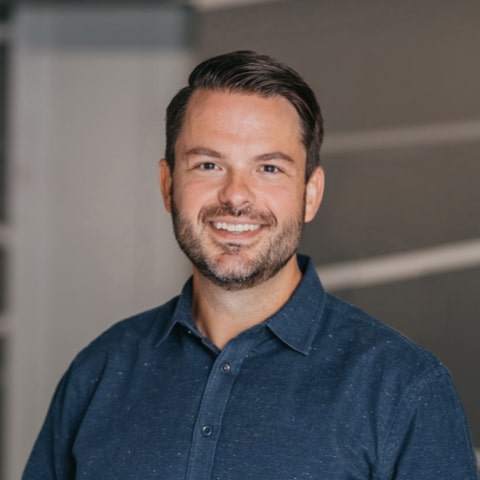
Cory Wheeler
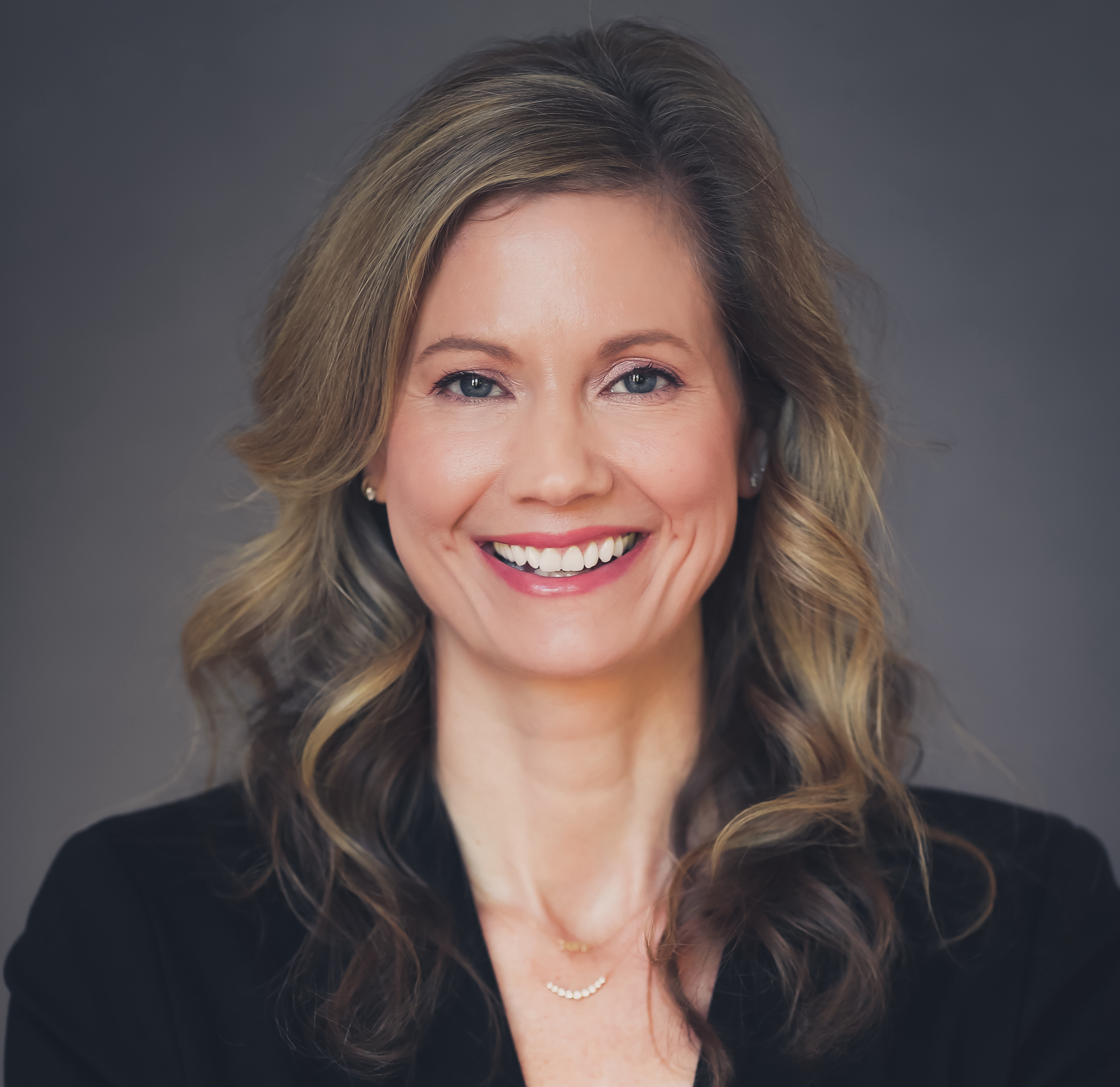
Meredith Albertson
Today's Guests



